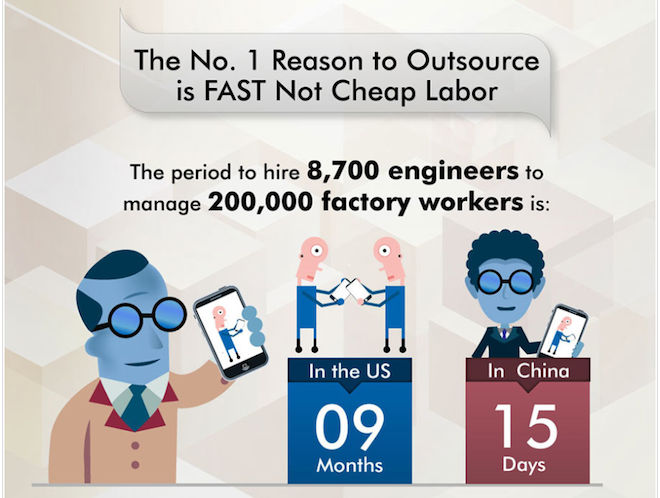American components in Apple's iPhone supply chain graphically detailed
Last updated
A report examining Apple's component supply chain and global manufacturing details the source of the parts, workers and assembly involved in building the company's devices.
Source: Finances Online
Alex Hillsberg of Finances Online produced an infographic outlining the source of Apple's iPhone components, right down to the rare earth metals involved in manufacturing high tech parts from its display and speakers to its silicon and vibration motor.
"Most rare earth metals come from China," the report states, noting that 90 percent are mined in Inner Mongolia and China. The graphic also presents Apple's global workforce and depicts why Apple assembles most of its devices in China, emphasizing "fast, not cheep labor," as depicted in an excerpt of the infographic, above.
Hillsberg also draws attention to such rarely reported facts as Foxconn's production of 40 percent of the entire world's consumer electronics, including products from Amazon, Dell, HP Motorola, Nintendo, Nokia, Samsung and Sony.
Many reporters describe Foxconn as being an "Apple factory," particularly when describing suicides and industrial accidents that have occured there, even ones unrelated to the manufacturing of Apple products.
Apple's chief executive Tim Cook has in the past pointed attention to iPhone components made in the United States, stating in a 2012 interview with Brian Williams, "we’ve been working for years on doing more and more in the U.S. Next year, we’re going to do one of our existing Mac lines in the United States," a product he later revealed to be the Mac Pro.
Cook specifically noted Corning's 'Gorilla Glass' face for the iPhone as being manufactured in Kentucky and its A-series SoC processor manufactured at Samsung's Austin, Texas facility.
When asked about the labor costs involved with moving manufacturing back to the United States, Cook replied, "It’s not so much about the price as it is about the skills, etc. Over time, there are skills associated with manufacturing that have left the U.S.,†Cook said.
"The consumer electronics world was really never here," Cook stated. “It’s not a matter of bringing it back, it’s a matter of starting it here."
 Daniel Eran Dilger
Daniel Eran Dilger















 Amber Neely
Amber Neely
 Thomas Sibilly
Thomas Sibilly
 AppleInsider Staff
AppleInsider Staff
 William Gallagher
William Gallagher
 Malcolm Owen
Malcolm Owen
 Christine McKee
Christine McKee










60 Comments
Where?
Ok I found it.
There is nothing new or secret being divulged here.
While the fast labor infographic may be true, it's not as if China always had that advantage. Originally most of that manufacturing capability belonged to the US. That's because most of the engineering expertise was here. Over the years, as companies were seeking to maximize their profits, they started shipping much of that expertise over to China. At the same time, they lobbied Washington, to bring down the tarrifs for goods manufactured overseas. Over one generation, that manufacturing capability has now shifted over there. This has effectively gutted that same capability in the US. So to just blurt out that statistic, is a bit disigenuous IMO. They did not acquire that expertise, overnight through the holy spirit. US companies, gave it to them witht the full collaboration of US government.
While the fast labor infographic may be true, it's not as if China always had that advantage. Originally most of that manufacturing capability belonged to the US. That's because most of the engineering expertise was here.
Over the years, as companies were seeking to maximize their profits, they started shipping much of that expertise over to China. At the same time, they lobbied Washington, to bring down the tarrifs for goods manufactured overseas. Over one generation, that manufacturing capability has now shifted over there. This has effectively gutted that same capability in the US.
So to just blurt out that statistic, is a bit disigenuous IMO. They did not acquire that expertise, overnight through the holy spirit. US companies, gave it to them witht the full collaboration of US government.
I think your timetable is a bit wrong. The majority of electronics manufacturers have been overseas for more than 20 years. Most of the products I bought as a young adult were being built in Japan, not the US, and I just turned 60. China might have come later but I would guess the last TV or radio built in the US in any quantity was done in the 70's or at best 80's. Yes, a lot of stuff was designed her but the US has been out of the manufacturing loop for several decades.
Is this good? No, I'd like to see more construction performed in the US but I doubt it will happen because many Americans aren't willing to work the kind of hours necessary doing repetitive work that's required to bring a product to market that doesn't cost a million dollars. Most non-hispanic Americans aren't willing to do farm labor either, which is why they are "imported" into the US where there's plenty of fertile land and water to grow things.
While the fast labor infographic may be true, it's not as if China always had that advantage. Originally most of that manufacturing capability belonged to the US. That's because most of the engineering expertise was here.
Over the years, as companies were seeking to maximize their profits, they started shipping much of that expertise over to China. At the same time, they lobbied Washington, to bring down the tarrifs for goods manufactured overseas. Over one generation, that manufacturing capability has now shifted over there. This has effectively gutted that same capability in the US.
So to just blurt out that statistic, is a bit disigenuous IMO. They did not acquire that expertise, overnight through the holy spirit. US companies, gave it to them witht the full collaboration of US government.
The "companies were seeking to maximize their profits" meme is biased. Companies didn't simply move manufacturing to China in order to maximize profits but also to lower prices. Marketplace domination could be had by a company producing a same or near-same quality item and lower cost. Maybe you keep some of that extra savings for yourself, but the main thing you're doing is just making sure you're the guy getting the sales to a price-conscious public. Government and companies had a role in things moving to China, but a public that didn't want to buy anything except the lowest price item had a bigger role.